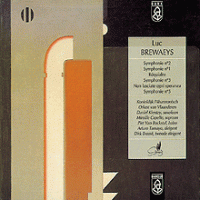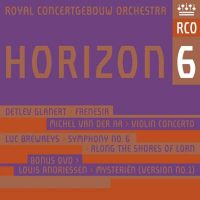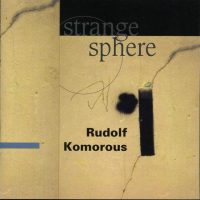Of Scotch and Stardust
|
Dan Albertson [February 2017.] [Words are inadequate to thank Liao Dieer for his ability to find value in the mundane; to cajole and reprimand; to delight in myriad ways.]
Luc BREWAEYS: Réquialm (1989, S & small orchestra)*; Symphony No. 1, ‘…e poi c’era…’ (1985); four others. Mireille Capelle (S)*; deFilharmonie, Arturo Tamayo (cond.). Cypres Records CYP 2609 (2 CDs, O/P) (http://www.cypres-records.com/). “Horizon 6.” Luc BREWAEYS: Symphony No. 6 (2000, with live electronics); four others. Koninklijk Concertgebouworkest, David Robertson (cond.). (1 SACD + 1 DVD) RCO Live RCO 15001 (https://www.concertgebouworkest.nl/en/webshop). “Strange Sphere.” Rudolf KOMOROUS: Ritratto di Laura Battiferri (1989, 2 vn, 2 va, 2 vc); Lurid Bride (1999, a fl, ob, b cl, vn, vc, db, pf, perc); three others. Turning Point Ensemble, Owen Underhill (cond.). Canadian Music Centre CD-ART 030 (http://www.musiccentre.ca/). A composer pair with nil in common. Life is meant to be paradoxical. The first (1959-2015) counted Donatoni and Xenakis among his mentors, whatever one could learn from them. His music is unafraid of lyricism and muscularity in equal proportions, with a tendency to brood. He is the Scotch here, a passion for which reflected itself in several titles: Talisker, Laphroaig, Bowmore, OBAN. The second (b. 1931) fled Soviet tanks, but only after two formative years in pre-Cultural Revolution China, and settled in western Canada. His œuvre occupies a surrealist no man’s land: tragic, comic, brash, esoteric, and none of these; neither Eastern nor Western; fanciful yet grounded in terra firma. One photograph shows him holding a lawn gnome, their wry smiles almost a match. Stardust ranks among his beloved tunes and he even wrote a symphony, or in his spelling sinfony, based on it. * Revisiting the first bit of Brewaeys that I ever heard, Réquialm, immediately reminded me of his virtues: From an unlikely textual source, by Hans G. Helms, he crafts a vocal line of undeniable charm. The orchestral texture is as much chamber music as ensemble, jarring here, almost disappearing there. Only the third song is protracted. His Symphony No. 6, with hesitations and palpitations, takes a while to find its way forward. The composer poises his progress on the fringe of forbearance and resistance; neither one prevails as the symphony goes on to develop the quality of a cortège. One could forgive the live electronics, which add little to the texture apart from manipulated tintinnabulation. It is a piece without consolation, with even the bells seeming aloof, offering neither solace nor menace. The Symphony No. 1, far from a young man’s cri de cœur, relishes its pensiveness, charting a trajectory from nearly inaudible noise to a hushed Dies Iræ, seldom reaching a “normal” volume. Its final chord must be a joke. * A string sextet with not a trace of Brahms, the Ritratto di Laura Battiferri is also not a portrait, despite its titular reference to Bronzino. Instead, the composer attempts to capture the illusory essence of the painting as well as its structural rigor. He succeeds on each count. Cast in a single movement with swells and withdrawals, and with the instruments splintering into subgroups, the music is more subdued than is his norm – monochromaticism with intent. A still life, repurposed, a work of immense Innigkeit. On the same disc is Lurid Bride, a phantasmagoria in sound, a suite of 11 varied movements, though one with certain idées fixes, not least a percussive thump and a growing melodic concern. The wind sonorities are of particular interest; Komorous, never one to settle for conventional instrumentations and himself a former professional bassoonist, here eschews harmonica and melodica, two of his choice winds, but achieves a wondrous gamut, both in terms of register and sentiment. Why he has never become renowned is fairly clear: The business seeks conformity and he seldom writes comfortable music for received formations. An orchestral commission from Donaueschingen, for instance, yielded a score for 2 English horns, 2 basset horns, 4 bassoons, 6 French horns, 4 trombones, piano, 2 harps, 2 vibraphones, marimba, 6 violas, 6 cellos, and 6 double basses. Not one for the repertory. He is a prescient figure, one who wrote for period instruments in the infancy of the brigade; one whose immersion in Chinese and Japanese culture has led to a series of supreme creations, both instrumental and vocal, the latter including settings of Hanshan, Li He, Li Qingzhao, Li Shangyin, and Wang Wei; one who was interdisciplinary before such a neologism, now a cliché, existed. He will get his due, if not for the canon of today, then for the imagination of tomorrow. * I have become increasingly drawn to those artists operating not on the periphery, but rather at a fair distance even from there. Komorous embodies a universe all his own, and has no comparison; Brewaeys, while much more mainstream on paper, is nonetheless an individual case, his introspection setting him apart from his quasi-spectral colleagues. Maybe, in hindsight, the two are related: The mechanics of melancholy are deep here, and oblivion – or is it Shangri-La? – is never out of grasp.
[More Dan Albertson]
[Previous Article:
Pièces de Clavecin 9: Older and Newer Rameau]
[Next Article:
Used Bin Troll Tweets X.]
|


